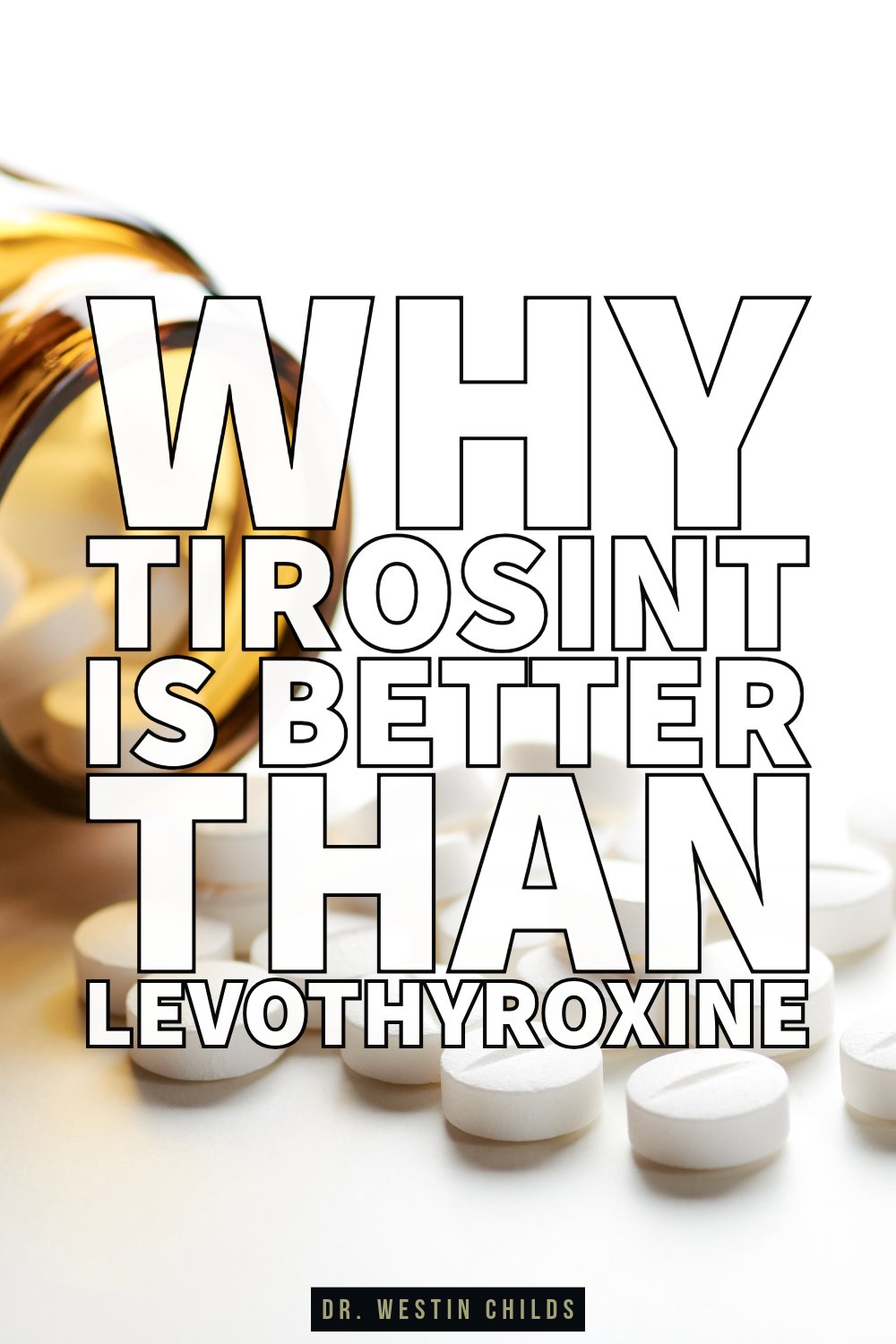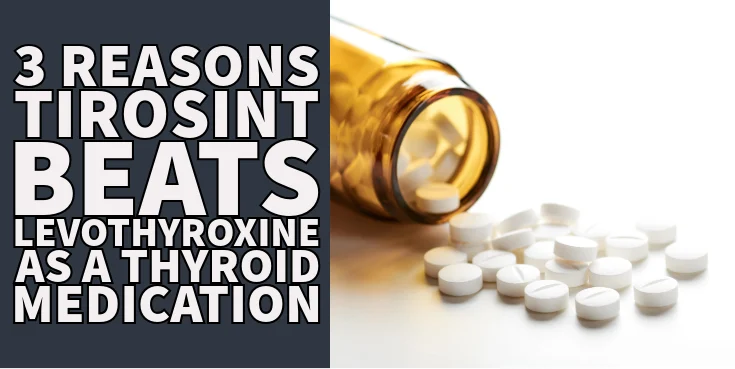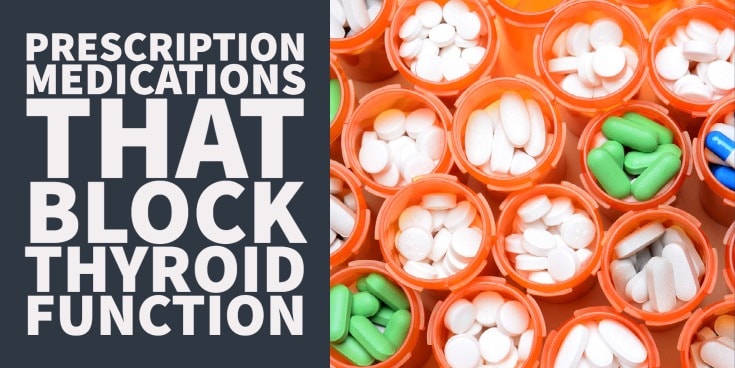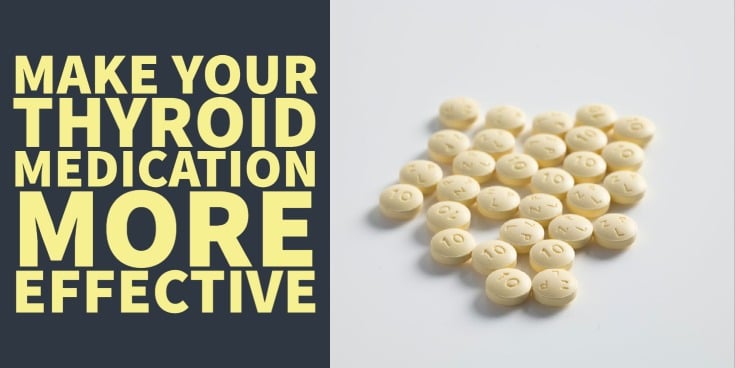I’m always surprised to find out that thyroid patients aren’t aware of the many thyroid medications available to them besides levothyroxine.
Doctors, for reasons we’ve discussed elsewhere on this blog, are persistent in their drive and desire to prescribe levothyroxine for pretty much every thyroid patient.
Unfortunately, as many of you have found out, levothyroxine just simply doesn’t work well for every single thyroid patient.
Sure, it works well for some but for others, it may actually make them feel worse.
But what is a thyroid patient supposed to do in this situation?
Give up and just slog through every day taking a medication that isn’t working for them?
No way!
This is where Tirosint comes in.
Tirosint is a relatively newer thyroid medication that came out in 2006 (new compared to other thyroid medications which have been out for decades).
Tirosint has some special properties that make it particularly attractive to people who are using levothyroxine and not feeling better.
One of those is the fact that it is comprised of 100% T4 thyroid medication.
This means that Tirosint is VERY similar to levothyroxine (except where it counts, which we will discuss below).
That may not sound good to you at first until you realize that because it is so similar to levothyroxine your doctor is much more likely to give it to you over other forms of thyroid medications like NDT or Cytomel.
I’m not saying Tirosint is the best thyroid medication out there by any stretch of the imagination.
But it is certainly better than levothyroxine for MOST thyroid patients.
Here’s why:
#1. It’s Cleaner.
Tirosint is one of the cleanest thyroid medications on the market.
And by clean what I really mean is that it has far fewer inactive ingredients compared to other forms of thyroid medications.
Take levothyroxine, for instance.
Levothyroxine contains the following inactive ingredients:
- Magnesium stearate
- Microcrystalline cellulose
- Colloidal silicon dioxide
- Sodium starch glycolate
- Lactose monohydrate (in the case of Synthroid (1))
- Acacia (in the case of Synthroid)
- Food colorings/dyes (2) including Yellow no. 6, Blue No. 2, Yellow No. 10, Red No. 27, Red No. 30, Blue No. 1, and many others (the colorings and dyes vary based on the tablet strength)
Compare this to Tirosint which contains (3):
- Gelatin
- Water
- Glycerin
The inactive ingredients found in levothyroxine and Synthroid are known as excipients.
These excipients (or inactive fillers) do not actually contain active medication but instead serve a different purpose.
They help to stabilize the medication (in our case, levothyroxine/thyroxine) while also doing other things such as delaying when the medication gets absorbed and so on.
Other excipients serve no purpose other than changing the color of the pill with dyes.
These dyes have some potential in helping to reduce confusion among patients but it’s not without cost.
Excipients are thought to be “inert” meaning they weren’t supposed to cause any issues or interfere with your ability to use a medication.
We now understand that this assumption isn’t true. In fact, we now have significant evidence to show that these excipients can cause issues for many patients (4).
This is particularly true of thyroid patients who tend to respond negatively to the excipients in many types of medications including levothyroxine and Synthroid.
Let’s take lactose monohydrate as an example.
Lactose monohydrate is found in some versions of levothyroxine/Synthroid.
Lactose monohydrate contains lactose which is a milk sugar found in dairy products.
Many people around the world are what we call lactose intolerant, meaning they can’t tolerate lactose.
Compared to the normal population, thyroid patients tend to have more issues in tolerating both dairy proteins and dairy sugars.
You can imagine the problem this can cause for a thyroid patient who has problems tolerating lactose and yet is taking a medication that contains that very substance.
It can block the absorption of levothyroxine and can even cause resistance to your levothyroxine as evidenced in this case study (5).
It doesn’t stop there, though.
We know from other studies that removing lactose from your diet can improve thyroid function in patients with Hashimoto’s thyroiditis (6).
Why this ingredient is found in some versions of levothyroxine, the most commonly prescribed medication to treat low thyroid, remains a mystery to me.

What you need to know is that your levothyroxine may not be working BECAUSE of these inactive fillers.
And, by the way, we’ve only talked about one inactive ingredient so far.
Another common ingredient that can cause issues is acacia.
Acacia refers to a family of shrubs and trees and this is another substance that people have trouble with (7).
If you are someone who already suffers from seasonal allergies to pollen or grass then there’s a chance you might also have issues with acacia.
An allergy to the acacia in Synthroid may result in allergy-like symptoms when you take it.
We don’t have a lot of data on how many people actually have an issue with acacia but I suspect it’s quite high given my own experience.
In addition, it’s still possible for you to react to the other inactive ingredients, dyes, or starches found in your version of levothyroxine.
So when we talk about how clean a thyroid medication is, it actually matters.
How do you know if you are reacting to these inactive fillers? You can take a look at your symptoms.
Reactions to inactive ingredients are quite broad and can vary from person to person.
Some people may not even react at all to these fillers while other people may have significant reactions.
As you can imagine, the symptoms you might experience can vary from individual to individual as well.
Reactions to excipients may cause any or some of the following symptoms:
- Gas/bloating
- Stomach pain
- Allergy-like symptoms
- Runny nose
- Abdominal pain
- Headaches
- Cramps
- Diarrhea
- Constipation
- Swelling
- Rash
- Hives
- Itching
Many of these symptoms are nonspecific and can be difficult to really track down.
Because of this, you need to pay attention to WHEN your symptoms started and if they correlate with when you started taking your thyroid medication.
Keeping a symptom journal or symptom log can really help in these situations.
By keeping track of your symptoms, the time of day that they show up, how long they last, and so on, you will be able to recognize patterns and lock down the cause.
Switching to a cleaner thyroid medication, such as Tirosint, can also help.
I know from experience that many thyroid patients notice considerable improvement almost immediately after switching, especially if they are experiencing reactions to the inactive fillers/dyes.
Due to this, and because thyroid patients tend to be more sensitive to inactive fillers and dyes at baseline, I often recommend Tirosint as first-line therapy to thyroid patients over levothyroxine.
Switching thyroid medications doesn’t guarantee that your symptoms will be fixed, but it’s a great place to start.
#2. It is Better Absorbed.
Another huge benefit to taking Tirosint, which is an extension of number 1 above, is that it’s often much better absorbed compared to levothyroxine.
Many thyroid patients are taking the right dose of levothyroxine but they aren’t feeling better because that dose of levothyroxine is not getting into their body.
Absorption is so important when it comes to taking levothyroxine because it’s a rather sensitive medication.
This is exactly why your doctor/pharmacist recommends that you take levothyroxine on an empty stomach, away from other medications, away from food/water/coffee, and away from supplements.
Each of these has the potential to interfere with your dose of levothyroxine and may actually prevent it from being absorbed into your intestinal tract.
It may sound gross, but much of your levothyroxine may be exiting your body in your stool as opposed to entering your body to help you feel better.
The dyes/fillers/inactive ingredients above may play a role here but other factors such as the integrity of your gut are also important.
Any sort of inflammation or problem in the gut can potentially cause issues with levothyroxine absorption.
This includes issues like irritable bowel syndrome, inflammatory bowel disease, acid reflux, the use of acid blockers, and chronic constipation are all indicators of gut issues and people with these conditions will have a harder time absorbing levothyroxine.
How do you get around this?
One option is to use Tirosint.
Because Tirosint has so few inactive ingredients it’s much easier for your gut to break it down and then absorb it.
We know from studies (8) that Tirosint can be absorbed even when taking it with food and/or coffee!
This is certainly NOT true of levothyroxine.
If you try taking levothyroxine with food or coffee I can almost guarantee that you will have issues absorbing it.
In addition, because Tirosint is in a gel cap, it’s also a little bit easier to take via the sublingual route.
It’s possible to break the gel cap and put the liquid contents of levothyroxine directly into your mouth and allow for more rapid absorption under your tongue.
This method can work for other types of thyroid medications but obviously works best in thyroid medications with fewer inactive ingredients.
If you want to read more about taking your thyroid medication under your tongue then check out this post.
Put simply:
The more thyroid medication you absorb the better you will feel.
So anything you can do (or take, in this instance) to increase absorption of your thyroid medication is a good thing.
#3. Taking it is Easier.
I like to think that every thyroid patient out there is listening to all of the information I put out.
In my head, I’m sure every single one of you is taking your thyroid medication appropriately (as outlined here) so as to avoid any issues with food/beverages.
I know for sure that you are also waiting the appropriate amount of time after taking supplements containing iron and calcium!
As much as I’d like to believe this, I know it isn’t true.
And this is where #3 comes into play.
Tirosint is much easier to take compared to levothyroxine because it provides more flexibility in HOW you take it.
Imagine if you were able to take your thyroid medication at ANY time of the day, with food or without, with coffee or without, and with your supplements.
Do you think that you’d be MORE likely to take it every day or less likely?
I’d bet that you would be much more likely to take it.
Because Tirosint has a much more favorable absorption profile compared to other forms of levothyroxine, you can be much more flexible in how you take it.
I don’t often recommend taking thyroid medication with food even when taking Tirosint because it’s always better to be safe rather than sorry.
But if it comes down to you forgetting to take your thyroid medication or taking it with food then I’d prefer the latter.
The Major Downside:
The cost.
Because Tirosint is the name-brand version, it’s significantly more expensive compared to levothyroxine and Synthroid.
The pricing of thyroid medications is always changing but, right now, goodrx.com is showing a 1 month supply of Tirosint at around $125 dollars.
This is significantly more expensive when compared to levothyroxine which is around $4 per month (or less).
The good news is that as of late 2020 and early 2021, there is now a generic. version of Tirosint available.
This generic version is available from Teva Pharmaceuticals as well as Lannett.
At the time of this writing, you have at least two different pharmaceutical companies that produce a generic version in most doses.
If you want to doctor to prescribe a generic Tirosint make sure they write a prescription for levothyroxine (capsules) instead of just writing a prescription for levothyroxine.
Alternatively, you should also be able to get Tirosint if your doctor writes a prescription for “Tirosint” but does not put “DAW” on the RX.
DAW means that the prescription MUST be provided exactly as written and is a way to ensure that you get the brand name.
If your doctor puts Tirosint without DAW then the pharmacy has the ability to sub out the brand name for a generic version.
This little trick also applies to levothyroxine and Synthroid, by the way!
Final Thoughts
Let’s wrap it up:
Tirosint is a relatively newer thyroid medication that has several advantages over other forms of levothyroxine.
Like levothyroxine, Tirosint contains only T4 thyroid hormone.
Not everyone does well on T4-only thyroid medications but there are some who still may benefit from using it.
Because it contains so few active ingredients it is more readily absorbed by the body, thyroid patients may experience fewer reactions when taking it, and thyroid patients have a lot more flexibility in HOW they take it.
For these reasons, it’s my go-to T4-only thyroid medication.
One of the biggest downsides to using Tirosint is the cost.
Fortunately, there are several ways that you can reduce the cost including coupons, insurance coverage, and even using a generic version.
If you are someone who is having issues with levothyroxine or Synthroid then switching over to Tirosint is something you may seriously want to consider.
Now I want to hear from you:
Are you having issues with levothyroxine or Synthroid?
If so, are you considering using Tirosint?
Are you already taking Tirosint? If so, how is it working for you?
Have you tried taking the generic version of Tirosint? If so, how did it work?
Let me know in the comments section below!
Scientific References
#1. https://www.accessdata.fda.gov/drugsatfda_docs/label/2008/021402s011lbl.pdf
#2. https://www.accessdata.fda.gov/drugsatfda_docs/label/2017/021342s023lbl.pdf
#3. https://www.accessdata.fda.gov/drugsatfda_docs/label/2007/022121lbl.pdf
#4. https://pubmed.ncbi.nlm.nih.gov/17017910/
#5. https://pubmed.ncbi.nlm.nih.gov/17123345/
#6. https://pubmed.ncbi.nlm.nih.gov/24078411/
#7. https://pubmed.ncbi.nlm.nih.gov/16804326/
#8. https://pubmed.ncbi.nlm.nih.gov/24351573/










Hello, I’m taking Levo and my blood pressure is up significantly than normal when taking it. Doctor doesn’t seem to care just wants me to take my BP meds instead of helping me balance it out.Really sad so that’s why I’m on your website!!
Hi Carlos,
Thyroid medication definitely can increase blood pressure. I would take a look at this article for more information on that topic: https://www.restartmed.com/thyroid-medication-high-blood-pressure/
Do you know what the conversion of Tirosint and cytomel to synthroid should be?
Hi Debbie,
Tirosint to Synthroid will be straightforward but the conversion with cytomel will require some changes. Please see this post: https://www.restartmed.com/thyroid-medication-dosage-chart/
I have taken the generic version of Tirosint made by Lannett without any adverse response to it. I do not do well with Synthroid so I was hesitant to try Tirosint but was pleased that I felt nothing adverse, at all, to taking it.
Hi Ruth,
Glad you found something that works for you!
Is it ok to take the Tirosint capsules with Liothyronine? Or will one interfere with the other?
Thank you,
Alice
Hi Alice,
It will probably be okay but it’s usually best to take them away from each other.
I’ve been taking Tirosint for over 8 years now, it used to be much cheaper than it is now but I use the coupon from the manufacturer and pay $25. instead of $50. per month.
My endocrinologist switched me to it because I was not absorbing the Levo.
I also take it at night before bed instead of the morning because I take my vitamins in the morning so this works well for me but I still have weight loss issues.
Anyway, that’s my experience. Thank you so much for your post!!
Hi Desiree,
There are now some generic versions of Tirosint available so I would look into those to see if they are cheaper!
Hi Desiree, May I ask, what pharmacy do you go to??? I haven’t been able to find Tirosint for any less than $50.00 a month. Thanks a lot for your comment and information.
I am here because I’ve become desperate in seeking a solution to my current issues.
I took Levothyroxine for about a year and it worked. Then, BOOM! Menopause hit like a ton of bricks! I had to stop my Levothyroxine because I was suddenly experiencing severe anxiety, headaches, gut issues, etc. Taking the Levothyroxine seemed to make these issues much worse. I haven’t taken any thyroid meds in a while. I am severely anxious, experiencing diarrhea, and feeling a lot of chest pressure. I recently thought I was having a heart attack and was admitted into the hospital. All heart testing was perfect.
I am now on HRT and am supposed to start Tirosint tomorrow. I hope and pray this will give me my life back.
Hi Heidi,
I hope it works for you as well! Keep us updated 🙂
Hi, I’ve been on Armour for about a year and simply couldn’t get the T4 to budge. Developed severe neuropathy, muscle twitches, pain etc. the more we pushed it up. My doctor switched me to 125 of Tirosint and 7.5 of Cytomel in June. TSH dropped way too low and we dropped the Tirosint to 112 and Cytomel to 5mcg. I now developed severe indigestion, chest pressure, heart palpitations, rock in my throat, stomach feels like a volcano, bad headaches, diarrhea, etc. I’ve been off sugar, dairy, gluten since July and maybe all that has helped absorption. Im wondering if this is all from Cytomel not Tirosint but I’m extremely hesitant to drop T3. I’ve never not been on T3. Thyroid was removed 2 years ago and haven’t been able to stabilize since. However I can’t take this pain anymore. Thoughts?
Hi Dina,
Cytomel is much more likely to cause those symptoms compared to Tirosint but it’s possible that one or both could be contributing.
Don’t discount adrenal involvement too—adrenals and thyroid work closely together, so it’s hard to untangle which symptom is tied to which gland. A four-times-a-day saliva test can give you an idea what’s happening with your adrenals. Sometimes it’s a thyroid dosing issue, sometimes it’s another condition or two muddying the waters. Best of luck to you!
I could not take Levothyroxine and also did not respond well to Synthroid. I did much better on Tirosint, but changing insurance plans created havoc with pricing. I got it at a compounding pharmacy for a while for what I felt was a reasonable cost. Interesting to hear that generics are now available. I switched to Armour, but stopped that when I was also diagnosed with Celiac Disease since Armour has gluten. I’m currently on NP Thyroid, which has been the most effective for me since starting this journey 6 years ago.
Hi Elise,
Please see this article regarding the gluten content of thyroid medications: https://www.restartmed.com/thyroid-medication-gluten-free/
any suggestions for someone whose body does not convert t4 to t3 well, if much at all? had a lab that used to make the t3 and they stopped. haven’t had it in years, but when i was taking it i felt the best i have since the surgery to remove the thyroid. losing weight is next to impossible…. if it drop the levo below 175/day, i fall asleep at the wheel… please advise
Hi Amanda,
Yes, please see this post for more information: https://www.restartmed.com/increase-free-t3-naturally/
Hi Dr.Westin,
I started Armour Thyroid after taking Synthroid for years. Schedule appointment with Endocrinologist and they refuse to prescribe Armour Thyroid so back to square one. My Thyroid panels are ok (TSH only) so family Dr reluctant to change medication. I ‘ll discuss Tirosint with family Dr if you feel better than natural Armour Thyroid! My issue is keeping essential hypertension under control! Along with typical Hashimoto thyroiditis w hypothyroidism symptoms!!!
Thank you!
Annie S.
P.S. I love Hashimoto thyroiditis bundle supplements you created
!!!
Hi Annie,
Glad you like them! And, yes, discussing Tirosint sounds like it would be a great option for you.
Hi. After trying several other brands I found Tirosint 75 mcg (and Liothyronine Sod 5 mcg) a few years ago and began feeling better. The only caveat is my weight continue to creep up regardless of my strict diet and working outs. It is very frustrating… Thoughts? TY
Hi Julie,
Yes, check a complete thyroid lab panel 🙂 You are probably not dosed correctly: https://www.restartmed.com/normal-thyroid-levels/
I switched to Tirosint last year when NPThroid and others had a recall and their dosage was not dependable. I had been having fatigue issues while on NPThroid so my doctor switched me to Tirosint. Within one month I gained 25lbs and can’t lose it. So, while I have no reactions and my fatigue issues are a bit better, the weight gain is horrible. I am also on 5 mg of Cytomel with no effect on the weight issue.
Hi Meltem,
That sounds like a dosing issue. My best guest is that you were not converted properly from your NDT dose to T4 + T3.
What are your views on Unithroid? I am on Unithroid 100mcg. I take it between 2:30-3:30am. Should I try to take it at the exact same time every day? I only take it with water. I take supplements at breakfast. I had my thyroid removed in 2012 due to nodules. I am 57 and in menopause. Could this be the reason for the weight gain?
Hi Susie,
I would put Unithroid in the same boat as levothyroxine. It still contains fillers, dyes, and even lactose which can all be a problem for thyroid patients.
I take Tirosint and also Lyrothrinine. My nurse practitioner ch Changed me from levoxel to tirosint when I was not Feeling well. I was tired and my hair was starting to fall out. I have been on it for 8 weeks and I am feeling a lot better and my labs have improved. My hairless has slowed significantly. Yes it is pricey but I buy it by the 3 months supply from a Mississippi pharmacy, so it is less expensive to buy it that way. My insurance won’t cover it so I just pay for it out of pocket . I don’t mind paying for it because it is worth it on how I feel.
Hi Renae,
I agree! If you find what works for you then it’s best to stick with it.
Thank you for the article! Do you have a suggestion as an alternative to Tirosint? I experienced panic attacks on both Synthroid and generic several years ago when I was first diagnosed with Hashimoto’s. I also had daily headaches and an increase in anxiety with Naturethroid. Recently, I thought I had found a good fit for me with Tirosint and it was going well for the first several weeks. I slowly started to notice muscle and joint pain that I did not connect with Tirosint until my first dosage increase when it dramatically got worse. It stopped when I discontinued and came back when I resumed. I tried capsules and SOL liquid. Now I don’t know what to ask my doctor for next. Compounded? I don’t think my insurance covers compounded so I’m wondering what to do now. Any suggestions? P.S. Not sure if my anxiety before was a side effect of the medication or adrenal related, impossible for me to know now but the muscle and joint pain with Tirosint was definitely related. Thank you.
Hi Carla,
Yes, there are many alternatives including some generics. Please see this post: https://www.restartmed.com/thyroid-medication-names/
I really appreciate the information you provide. It has helped me know what to talk to my doctor about. I had to stop taking nature thyroid. My doc had me on way too much and I was experiencing terrible symptoms on 75 mg (used to take 30 of armor) I could not sleep, or think straight and cried erratically among other symptoms. It literally felt like I was losing my mind, which I originally thought were peri menopause symptoms. I did not know what was going on until I searched symptoms of too much thyroid med and it described everything I was experiencing. After switching doctors, decreasing dosage drastically, then switching to Tirosint 50 mcg (only because I asked for it after reading one of your articles) and trying a separate T3 that I learned I just cannot take T3 med. I noticed on a very low dose that I cannot focus or think straight at all. Have you had patients that have also experienced this on T3?
One downside on Tirosint is I keep gaining weight and still don’t have the energy I’d like to have but I haven’t for many years. Maybe I am not on a high enough dosage?
How I wish more doctors had the knowledge you do, that I could find one in my are and I didn’t have to try to figure this all out myself.
Thankful you share your knowledge.
Hi Cheryl,
It can happen but it’s not typical or common.
On Nature Throid for 5 years. No problems then gone. Now the trouble starts. Unable to take levothyroxine or Tirosint. Now on low dose of Armour. A bit of a problem but I am still taking it. No relief for hair loss. Struggling since June 2021 to return to some normalcy.
Hi Linda,
Hopefully, Nature-throid gets back on the market soon!
I am new to this, only diagnosed with Hashimoto’s a couple months ago. Taking generic Levothroxine 25 mcg. I have been getting headaches fairly frequently and did not know this was a side effect to the medication. As they started shortly after I went on the medication, I suspected that was why I was getting headaches. Thanks for the heads up on the Tirosint
Hi Mick,
Happy to help!
Taking Tirosint for about 3 months now. Feeling better so far with the exception of some new burning sensations and nerve tingling. Not sure if it’s from the Tirosint or not but I didn’t have them before. ♀️
I was on Armour Thyroid for years and did fine.
I had a Cervical spine cortisone epidural injection and one day later began with chills and hot flashes That lasted for over a year with chills and hot
flashes. I tried to see the physiatrist who did the injection but he would not see me again and referred me to his nurse practitioner. I was miserable and couldn’t get any help. I requested a referral to a endocrinologist and that took over 6 months to see one.
She took me off of armour and said there way no way to prove I did not convert to T3. At least she believed me when I told her that levothyroxine made me crazy. That was the only way i could describe my symptoms. I am on Tirosint 112mcg
5 years later I am still having hot flashes and sometimes chills I still believe I need T3 as well. I also ended up with Covid and was in the hospital in July for 10 days. My hair is falling out and the hot flashes continue and are miserable. I had horrible hot flashes when I went through menopause.
My Doctor passed away and I am now in the Phoenix area. I am looking for a referral to a Dr. who understands someone with a very sensitive body like mine. I also have a genetic problem called Ehlers Danlos which probably contributes to my problems. I have tried to make an appointment with a Neurologist who specialized in Ehlers but am on the list for a possible appointment in March of 2022.
Do you make referrals? any suggestions? Also I was interested in your probiotics and wondered how it is different than the everyday probiotics.
Hi Anita,
I don’t have any referrals but you can use this resource to help you find someone: https://www.restartmed.com/how-to-find-a-doctor-to-treat-your-thyroid/
In regards to the probiotics, please see the videos on the product pages which explain how they are different:
https://www.restartmed.com/product/thyro-biotic/
Like Carla Moore, I experienced side effects with Tirosint: anxiety and dark thoughts. The same with DTE… it seems every T4 I take converts to RT3 and not T3… I don’t know what to do, I can’t lose weight and I have thyroid nodules that slowly grow…and it’s very hard to find a doctor who understands this T4 conundrum…
I have nodules and my thyroid was so enlarged my doctor threatened to take it out. I went gluten free in 2016. I had an ultrasound last year and my thyroid was back to normal size. I still have nodules but they aren’t worried about them now. I do take meds on and off for my thyroid but reducing your inflammatory foods should help.
Hi, thank you for the informative video. I took Nature-throid for several years and it worked good. Then when it got recalled a couple years back I got switched to Armor and haven’t been able to get a good balance with it. Would Tirosint be a good replacement for the Armor or do you know if Nature-thyroid is back and safe again? I definitely need to get off the armor but not sure what others options there are that I can share with my Dr.
I think she would be willing to try something else but doesn’t seem to know which one either.
Thanks,
Vanessa
Hi Vanessa,
Tirosint can be used in place of Armour thyroid but if you made the switch you would also need to add another medication in to replace the lost T3. Armour thyroid contains a combo of both T4 and T3 whereas Tirosint only contains T4. If you made the switch without replacing the T3 then you probably wouldn’t feel very well.
Your Posts are very helpful
Just read about Tirosint, but I have been taking raw Thyroid Grandular along with Levothyroxine trying to get off of the prescription for about a month now. Two days on then 2 days off the Levothyroxine. How is this compared to Tirosint? I need your advice!
Hi Jane,
I’m not quite sure I understand the question. Are you asking how Tirosint compares to levothyroxine or thyroid glandulars?
I also use Levo more then a year and at the beginning I started to feel better, and after some while my period changed what was very stable before, and I started to notice head aches when there were hot days. My doctor said that Levo is very pure and do not cause side effects till I looked up at the list of the side effects and they are impressive.
Thank you for the video and suggestion, will try to switch to Tirosint.
Hi Agnese,
Hope it helps!
A T4 only medication may work for some, but what if your body can’t convert T4 to T3? Wouldn’t it be better to stay on something like Armour or other meds that contain T3? Or, is it just that Tirosint somehow makes it easier for the body to convert the T4 in it to T3?
Hi Suzanne,
There’s nothing special about Tirosint which boosts T4 to T3 conversion. If you have a conversion problem then swapping over to Tirosint won’t help unless the underlying issue is managed.
Dear Dr. Childs, I read your article about Tirosint. I have been on thyroid medication for the past two years. Approximately 6 months after starting the medication I began to feel a flushing in my cheeks and around my eyes…there is no outer redness, it’s just a feeling of tightness in this area of my face. The feeling is like being embarrassed without the facial redness. I have been taking Eutherox 25mcg. My endochronologist lowered the dose to 12.5 mcg daily but after 6 weeks there was no change. I was then taken off of Eutherox and put on a generic thyroid medication from Walgreens. Again after 6 weeks there was no change in this flushing feeling on my face. So now I am back on the 25mcg Eutherox. It is not easy to get used to this feeling all the time. I wonder do you have any suggests and could Tirosint be a possible solution. Thank you.
Hi Howard,
It certainly could be and would be worth a shot but your symptoms could be caused by other issues as well.
I am currently having issues where the doctor can’t keep my numbers in the normal range. Im up yhen down then up again. Now finding out going through menopause. I just dont feel like the levo is doing what I need and if my numbers are in any of the normal range he will say Im fine. I have heart palpitations and recently realized I was getting to much again. How do I try this medication to see if it will help?
Hi Roxanne,
This medication requires a prescription so you will need to ask your doctor about it. It would take the place of your current thyroid medication.
PLEASE HELP….Had thyroidectomy in 2004, I take 30mg Armour Thyroid daily ….TSH is 66.19 , yes you read that right! ( endocrinologist didn’t order T4 and T3 tests for this test;'( He tested me last week for ” TSH with HAMA” I haven’t heard from him with the results. This is crazy insane!
Can you PLEASE make any suggestions as to what is happening?
THANK YOU Dr. Childs !!!!
Hi Barbara,
Unfortunately, it’s hard to say much based on the limited information and testing available. You’ll need to dive deeper with more tests while looking at factors such as absorption as well as things that may interfere with your lab test results.
I just heard from my endocronologist…He said the “TSH with HAMA testing demonstrates no interfering antibodies. This is true hypothyroisism and not artifact. Continue Armour Thyroid but add 25 mcg of levothyroxine daily. Follow up in a month.”
I do NOT want to take levothyroxing, would Tirosint be an option?
Thank you again!
Barbara
I was on armour for many years, I recently am experiencing a very uncomfortable chest pressure and fast racing heart, feelings of anxiety and I can’t concentrate or focus, I had my husband type this for me. I also have hives, been to the ER twice now in two months, they do the same thing each time, EKG, xrays and cat scan, they say everything is normal. I have an appointment with the Endocronologist but it’s in three months. What do we do, just suffer? Can I use CBD oil for these symptoms? Thank you.
Hi Angela,
Can you get in to see your primary care provider? There should be someone you can get into sooner than 3 months.
Hi there! The one thing you didnt mention – the most critical thing – is how well this new med converts to T3 vs Levo. As you know, it’s really the T3 that matters! Hope to hear from you. Thanks.
Hi Diane,
The ability to convert T4 to T3 is dependent upon your body, not the medication you are taking. In other words, if you have a conversion issue you will need to address that problem by finding the root cause and/or using T3 thyroid medications instead of those with T4. Hope this clarifies 🙂
Hi Dr. Childs
another article of yours re: High RT3 mentioned seizures meds could cause High RT3. – I have severe neuropathy due to chemo drugs 15 yrs ago and must continue taking gabapentin. I did try the protocol of halving my armour thyroid for a month and it did drop the RT3 to 10 (from 21), but as soon as I up my armour to full dose (90 mcg twice/day with 5mcg liothyrinine) the high RT3 comes right back making me hurt and not feel well. would being on straight T3 be something to try. What does of straight T3 would that be? thank you
Hi Janet,
Are you asking what the equivalent dose of straight T3 is relative to 90mg of armour thyroid? If so, please see this article which discusses how to make that conversion: https://www.restartmed.com/thyroid-medication-dosage-chart/
Hi I have changed from levothyroxine to compound T4 .My only problem is I can’t seem to get the dosage right . I was on 100 mcg of levo . I’m now waiting on a new script for 60mcg of compound . Does that sound the right conversion. Thanks
I am taking 112mcg. Of Tirosint and need to lower to 100 mcg. Can I just skip one day of the 112 mcg until I use them up?
Hi Pamela,
You’d want to touch base with your doctor to make sure they are okay with that schedule. That would probably be okay in most circumstances unless your doctor wants you to reduce your dose more rapidly for some reason.
I was on Synthroid for about 20 years until I was switched to generic levothyroxine by my pharmacy. I never felt great on Synthroid but I tolerated it well except for the pink dosage of the drug which I believe is either 112 or 125 mcg. I just remember it making me feel sleepy right after I took it and that never happened to me before. I also always had issues with my hair falling excessively out on Synthroid too. Other than that I felt ok on it. All of that stopped when I started taking generic levothyroxine about 6 years ago. (While on the cheap, generic levothyroxine, my irritable bowel got 10 times worse, I gained at least 20 pounds and my hair started falling out non-stop).
I’ve been gluten free on and off for years, but due to severe irritable bowel symptoms over the last few years, I’ve been forced to go permanently gluten free. Last year I started seeing an endocrinologist for the first time in over a decade because I wanted to get off of generic levothyroxine. After running out of my pills during Covid, I realized that the leg pain I’d had for 6 years all of the sudden stopped. It took about 4 days of no levothyroxine in my system for the chronic leg and ankle pain in my left leg to be completely gone! I had to stop and think what I did and I realized that the biggest change I’d made was to stop the taking generic Levothyroxine I’d just run out of. So I stayed off of it and felt pretty good for about 3 weeks. After that I took some old Synthroid for a while and then made an appt. with the endo.
Long story short, I asked him to put me on Tirosint after discovering it online. He did and I’ve been doing great on it so far. My TSH is still not in the normal range but getting very close. My last labs showed that I’m within 10 points of being in the normal range so he upped my dose again to 88 mcg. My problem is that once again, the pharmacy switched my prescription from Tirosint to generic Tirosint and after several weeks on it now, I constantly feel sleepy during the day. Fortunately I still have 2 boxes of the 75 mcg of Tirosint (brand) and I’ve started taking it again to compare them. So far, I do not feel as good on the generic Tirosint 88 mcg. as I do on the original version of Tirosint 75 mcg!
I’ve gone through an entire box already of the generic version at the higher dose and I’m falling asleep during the day all of the time on it, like I was when was I wasn’t taking any meds. But if I just take one dose of the Tirosint 75 mcg, even though the dose is lower than the generic, I still feel more energetic (and not sleepy). I haven’t called the endo yet because I have an appointment with him in about a month.
After reading your articles, I think it’s possible that for some reason the generic version of Tirosint (which is just as expensive, $150 for 3 months) probably doesn’t absorb as well in my system as Tirosint the brand which irritates me because now I have to fight with the pharmacy again to fill the brand and not the generic. Furthermore, what’s the point of making a generic version of Tirosint which appears to be just as expensive as the brand, that doesn’t seem to work as well? None of this is good. These drug companies seriously do not understand or care about the problems they cause to patients by including so many unnecessary inactive ingredients in their drugs.
Since the pharmacy I’ve been going to for years (Kroger) clearly has no problem switching my prescription to the generic whenever they feel like it, I’m going to find another pharmacy. I’m sure they are thinking about their profits too and if they can give me the generic version of any drug, I’m sure it works out better for them. All of my doctors have told me they always write my prescriptions for the brand only, so none of my prescriptions should have been switched, but this pharmacy does it every time so I’m done with them. I should have done it years ago. What really makes me mad is that I have 2 boxes of generic Tirosint ($100 worth) that I can’t use because when I take it, I feel too sleepy to function! This is just one more reason why the healthcare racket in the US is so bad for patients.
Hi Sonya,
Generic versions are not always as good as brand versions. This is particularly true for thyroid patients and can be seen in the case of Synthroid vs levothyroxine. You may be one of the unlucky few that doesn’t respond well to generic Tirosint. If possible, it would be worth looking into coupons for the brand name.
I have hashimoto thyroid disease and I never tolerated levothyroxine it gave me headache stomach upset and shakiness.my endocrinologist who is amazing put my on Tirosint and it doesn’t irritate my stomach no headache no shakiness I had completely stopped taking levothyroxine because I couldn’t tolerate it I have allergies to so many things I didn’t know levothyroxine had so many fillers and I can actually feel my body absorbing the Tirosint
Hi Tina,
Glad to hear you are doing better on Tirosint. Thanks for sharing!
I have taken many different thyroid medications over the years with continually increasing dosages. I am now taking the highest dosage of Tirosint and it’s been the same as everything else. I have no symptoms but my TSH number is always way out of range. It jumps around but right now it’s 9. My T4 number is off too, but they’re just numbers on a piece of paper to me. I feel the same no matter what I take, which isn’t any different than before I took anything at all. Again, no symptoms so how much does this matter?
Hi Tammy,
Have you tried pure T3 medication like Cytomel, liothyronine, or SR T3? If you haven’t felt better then it’s probably not the medication so much as it is the dose. It’s either that or that your symptoms are connected to something else which is also a real possibility.
If you have commercial insurance you can use the Tirosint co-pay card to lower the price significantly. Not sure why but Tirosint-Sol is much cheaper than the Tirosint Capsules. Personally, I prefer capsules because it’s more convenient to take. You can get the Tirosint Capsules for as little as $50 for a 3 month supply, which is cheaper than what I’ve been paying for Levoxyl, even with insurance! The Tirosint-Sol is available for as little as $0 for a 3 month supply, with commercial insurance. If you don’t have insurance they do have a Tirosint direct program which is reasonably priced. I have a 10 day sample supply of Tirosint-Sol and I’m thinking about giving it a try again.
Honestly, I’ve been a bit disgruntled about the poor bioavailability of Levo in tablet form when compared to capsule/liquid forms. If you take a 100mcg tablet of Levothyroxine you are not getting 100mcg. If you take Tirosint you WILL get what you’re taking. With these capsule/liquid formulations on the market the makers of Levo in tablet forms should be required to re-lable their doses.
I have personal insurance. But I have severe issues with my thyroid. TSH 36.24 uIU/mL recently and a couple of months ago
0.50 – 5.07 uIU/mL 83.10 H., I have had the most stress in my life in this last year. My hair was long it is almost all failing out. My arms and legs are like ice pics. I sleep constantly for 2 months. I tell my doctor they don’t hear me because I have been in recovery. I’m afraid I’m going to go to sleep and not wake up. I haven’t had any relapses just created like I am not worthy of their time so could you please tell me if I purchase this pill will it help my symptoms because I am static electricity mess. Thanks for your time.
Hi Lisa,
Are you referring to Tirosint? If so, Tirosint is a prescription medication and not available over the counter. With a TSH as high as you mentioned above, you should be on some type of thyroid medication but it’s not clear based on the way your statement/question was phrased.
If you are looking for extra support in the form of thyroid supplements, those are available over the counter and do not require a prescription medication.
Hi Dr! I have a question. I have POTS (tachy) and never had thyroid issues. Clean thyroid labs. Now for the past year my tsh was 5.8 and recently it’s 4.8. I was told that’s hypo and I should start tyrosint. I’m terrified to start any meds because my POTS. I heard thyroid meds has side effects that I already live with cause my pots, like (tachy, anxiety,etc). Soooooo with my TSH at 4.8. T3,T4 normal range. Antibodies good too. Is it really necessary??? I do have very bad fatigue though (debilitating some days). But weird that I have high cortisol & acth. Also very high prolactin.(not pregnant & no tumors found) Should i focus more on trying to support my thyroid naturally with selenium, zinc & iodine before trying tyrosint? If my t3, t4 are good wouldn’t a t4 medicine mess me up? Thank you
Hi Tiffany,
If you prefer the natural approach then using supplements is a great option but there’s really no downside to using both conventional and alternative medicine at the same time, it’s just a matter of preference.
If your prolactin is very high, you need to get that down asap. It causes fatigue and weight gain. I take Cabergoline 1mg twice a week for mine. No tumors or pregnancy here either, but Endo says I have to take this med for the rest of my life to keep prolactin low. Even on medicine it’s still at 28. I recently thought my thyroid meds (Synthroid 125mcg)must not be working because of my bad fatigue, unable to lose weight, brain fog, hair loss, lack of motivation, low mood etc despite my thyroid labs being normal. I recently found out that having hyperprolactinemia (high prolactin) causes low testosterone. Mine is at a 6. Low Testosterone in women can cause the same debilitating physical symptoms as hypothyroidism. So I would focus on your prolactin and get your testosterone checked too before you start a medicine you might not even need. I’m to start treatment for low T next month.
Dr. Childs.. I have been researching on why I still feel so terrible despite my thyroid labs being normal and started to think I needed to change my meds (Synthroid 125mcg). I got a FULL panel of labs done including all the ones you mention in your articles and my thyroid and everything else was essentially in the normal range. EXCEPT my testosterone. It was very, very low. Found out that having hyperprolactinemia lowers testosterone! I’ve been on Cabergoline 1mg twice a week for a year (1/2mg twice a week for 7 years before that) to keep my prolactin low, but nobody ever told me that it would cause Low T. So now I’m contemplating low T treatment and also going to talk to my endo about switching to Tirosint due to being lactose intolerant AND allergic to pollen and grass. No wonder I feel like crap! My EOS (absolute) markers on my blood work have always been above normal and I wonder if these inactive ingredients is why?
I’m back to write that I’ve switched over to Tirosint. Day 2- so far the pain in my fingers and cognitive issues have completely subsided. I’ve been on generic tablet form since 2010 but on Levoxyl for the past few years and feeling general unwellness and the inability to get the dose right. Absolutely love that Tirosint has added 37.5mcg, 44mcg, 62.5mcg doses and even have a 13mcg dose. The first company to recognize the need for more individualized doses. The cost for me to alternate two doses of Levoxyl is more expensive than me to order one dose of Tirosint through the Tirosint direct program. United Healthcare does not cover my Tirosint. Dealing with insurance is annoying so I don’t bother unless it’s major. As far as the generic goes it’s made by Lannett who just happens to be the maker of my old generic Levo I was on for years and did okay on so I feel confident that their generic gel capsules will be good too. Where to get this generic Tirosint and is it any cheaper than Tirosint direct?
I have been on levothyroxine for twenty years to treat a skin disorder. I gained 35 pounds during that time and no amount of diet and exercise has allowed me to drop any weight at all. My blood tests show that I’m at the bottom of the acceptable limits. With what I read, I’m prepared to either quit taking levothyroxine or request to have my doctor prescribe tirosint.
Yours thoughts.
I was in Levothyroxine Sodium 150MCG TAB so how much Tirosint should I be taking? My doctor prescribed 150 mcg and I’m wondering if that is not enough. She wants me to wait three months for blood tests and meanwhile I’m just exhausted which is new.
Hi Harriett,
The starting conversion is usually 1:1 in terms of dose when converting from levothyroxine to Tirosint, but some people find they need less or more, depending on their situation.